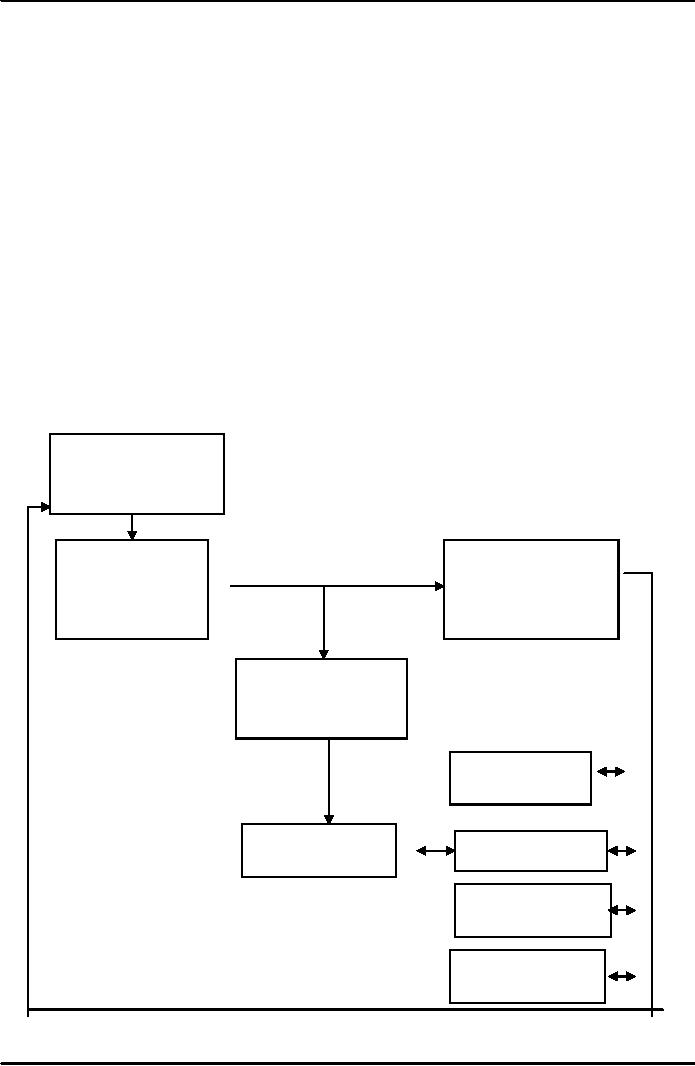 |

Introduction
to Psychology PSY101
VU
Lesson
42
INDUSTRIAL/ORGANIZATIONAL
PSYCHOLOGY
�
The
branch of psychology that
investigates the psychology of
the workplace.
�
Industrial/organizational
psychologists use the scientific
methods and knowledge for
studying
the
affects, cognitions, and
behaviors of people in the
work settings.
Major
focus of interest
How
best to fit the right person
to a given job.
How
best to fit the job to the
person
How
best to fit the right
person to a given job
What
does "doing a good job,"
mean?
Personnel
selection: How to select people
who do the job well?
Training:
How to train them so that they do the
job well?
Motivation:
How to motivate them so that they do the
job well?
How
best to fit the job to the
person?
Quality
of work life
Job
satisfaction
Worker
safety
Fitting
the right person to the
job
It
involves the
following:
a.
Job analysis
b.
Personnel selection
c.
Personnel training
d.
Worker's motivation
a.
Job analysis
�
The
first step in selecting the
right person for a job is to
do a job analysis.
�
Job
analysis is to prepare a specific
description of a job. It encompasses
the qualities and
behaviors
required of a person to do the
job properly.
�
It
is "the systematic study of
the tasks, duties, and
responsibilities of a job and
the knowledge,
skills,
and abilities needed to
perform it" (Riggio,
1990).
�
The
purpose of job analysis is to
find the best person
for the job.
�
For
this we have to be very
clear about the requirements
of the job.
�
Also,
these requirements have to be
translated into specific
measurable behaviors.
A
complete job analysis is a two-step
process
Step
1
Preparing
a detailed description of what a
person to be selected for a
particular job is expected
to
do.
�
The
job analysis has to be
specific.
238

Introduction
to Psychology PSY101
VU
�
Instead
of stating general duties it
should describe actual
behaviors that the person
has to
perform.
�
In
general the duties and
the responsibilities have to be
specified.
Step
2
�
Determining
the
performance criteria needed
for the proper performance
of a job.
�
The
specified duties and
responsibilities have to be translated
into measurable
personal
characteristics.
�
Here,
the Industrial/Organizational
psychological has to outline
the exact behaviors
and
characteristics
that a person ought to have
in order to perform the job
in the best
possible
manner.
`Hard'
Criteria and `Soft' Criteria
Hard
Criteria
These
are the objective
criteria.
These
criteria are obtained from
the available data e.g.
salary, number of units
sold, number of
absentees
etc.
Soft
Criteria
These
are the subjective
criteria.
Soft
criteria have a personal
touch and require a degree
of judgment i.e., sense of
humor,
congeniality,
creativity etc.
�
For
example the best student of
your college may be selected
on the basis of her grades,
or her
interaction
with fellow students, or
both i.e., soft as well as
hard criteria.
b.
Personnel Selection
�
Once
job analysis is complete,
the next task is to select
the right person for
the job.
�
Personnel
selection includes:
�
Devising
ways of selecting the best
applicant.
�
Making
decisions regarding
retention.
�
Making
decisions regarding
promotion.
�
Making
decisions regarding
termination.
Personnel
Selection: Functions of an Application
Form
�
It
can be a rough screening
device.
�
It
can supplement, or provide
cues for,
interviewing.
�
The
information contained in the
application form may be used
as a predictor of future
performance
e.g. academic record and
job history can be
indicative of a person's ability
and
potential.
Personnel
Selection: Employment
Interview
�
Employment
interviews can be structured or
unstructured.
�
Structured
interviews are preferred
over the unstructured
interviews.
�
These
consist of carefully phrased,
prescribed, uniform, and
fixed-ordered questions for
all
239

Introduction
to Psychology PSY101
VU
applicants.
�
Structured
interviews are considered
more valid than the
unstructured ones.
Personnel
selection: Use of Psychological
Tests
�
At
times the data obtained
through application form and
interviews may need to
be
supplemented
by psychological assessment.
�
Intelligence,
ability, aptitude, achievement, or
personality tests may be
used.
�
The
tests of cognitive functioning
(e.g. ability or achievement)
have been found to be
most
useful.
�
The
use of I.Q tests for
screening purposes is an issue of
dispute.
c.
Training the Selected
Personnel
�
Proper
training is a requirement and a
partial guarantee that the
selected person will do the
job
well
�
Training
refers to a systematic and
intentional process of altering
the behaviors of
employees
to
increase organizational effectiveness
(Gerow, 1997).
ASSESSING
TRAINING NEEDS
GOLDSTEIN'S
(1986, 1989)
SYSTEM
Assess
instructional
needs
Derive
Develop
evaluation
training/learning
criteria
objectives
Select
training
method
and media
Pretest
trainees
Conduct
training
Monitor
training
Evaluate
training
Evaluate
transfer
240

Introduction
to Psychology PSY101
VU
Evaluating
training Effectiveness
�
It
can be done in various
ways;
�
Taking
trainees' ratings
�
Assessment
by the organization i.e., measuring
effectiveness with reference to
training
objectives
d.
Workers' Motivation
�
Workers'
motivation affects efficiency
and productivity of the
organization.
�
A
team comprising unmotivated
workers will not be able to
attain the desired
goals.
Motivation
to Work
�
For
an organizational psychologist, what
motivates a person to carry on or
not his work is
much
dependent on three explanations.
They are;
�
Need
theories
�
Cognitive
theories and
�
Reinforcement
theories
Need
theories are primarily
based upon Maslow's
hierarchy of needs in which the
most basic needs
are
easily
fulfilled while complex needs
may be difficult to meet or
may remain
unfulfilled.
In
order for higher order
needs to be met; the basic
and lower level needs have
to be met first.
�
When
this theory relates to work,
it maintains that initially workers
are more concerned
with
salary
and job security but
when these requirements are
met, and then they
move towards the
more
sophisticated and complex
needs.
�
In
this way workers strive to
fulfill their requirements by doing
work
Cognitive
Theories of Work
Motivation
�
Theories
that focus on the cognitive
aspects of motivation; i.e. about
the job and the
work
place
as the motivational
force
�
How
people think, feel,
understand and expect about
the job are the
cognitions that
affect
motivation.
Expectancy
Theory
�
Workers
make logical choices to do
what they believe will
result in their attaining
outcomes of
highest
value.
Equity
Theory
�
Workers
are motivated to match their
inputs and outcomes with
those of fellow workers
in
similar
positions.
�
This
can be assumed to have a
basis in vicarious
learning.
Reinforcement
Theories of Work
Motivation
�
The
theory is based on the
learning principles and
maintains that motivation is
increased or
decreased
by the level and type of
reinforcement that is given to
the workers
�
Positive
reinforcement increases in production or
optimal production
�
Punishment
suppresses motivation.
241

Introduction
to Psychology PSY101
VU
�
No
reinforcement discourages
motivation.
Goal
setting as a motivational
technique
�
Setting
goals can motivate
workers:
�
Set
difficult but achievable
goals.
�
Goals
should be specific and
focused rather than general
and vague.
�
Feedback
regarding achievement of goals
should be regularly
provided.
�
Employees
should be aware of the
specific goals, and should
accept them as
reasonable.
�
Cultural
concerns should be kept in
mind.
In
collective cultures, where
working together is practiced,
involvement in goal setting is
more
important
than in individualistic
cultures.
Fitting
the Job to the
Person
�
Molding
the job and the
workplace in such a way that
workers put in optimal
efficiency and
productivity.
Job
Satisfaction
�
An
attitude toward or a collection of
positive feelings about,
one's job or job
experience
Factors
of Job Satisfaction:
�
In
job satisfaction, decision-
making is very
important.
�
Usually
two types of decision-
making may take
place:
�
Decentralized
decision- making
and
�
Centralized
decision- making
�
In
decentralized decision- making
the power extends throughout
the organization
�
In
centralized decision- making
power and authority rests in
the hands of just few
individuals
at
the top
�
Job
satisfaction is higher in organizations
following decentralized
decision-making.
Some
Facts about job Satisfaction
�
Younger
workers tend to be more
dissatisfied with their
job.
�
Older
workers are more jobs
dissatisfied by the end of
their careers.
�
There
are no significant gender
differences in terms of job
satisfaction.
�
There
is a positive relationship between
job satisfaction and
perceived level or status of
one's
job.
Nature
and Type of Job and Job
Satisfaction
�
It
depends on two
things
�
Job
clarity
The
rules and what is being
expected of the person from
the particular job are
explicit to the
worker.
�
Role
conflicts
242

Introduction
to Psychology PSY101
VU
It
has a negative effect on job
satisfaction.
It
arises when the person is
unable to perform the job
adequately and optimally
because the roles
and
responsibilities are not
clearly defined.
�
Role
conflict may make it easier
to hide mistakes.
�
But
it also leaves little room
for one's contribution being
clearly identified.
Ways
of Enhancing Job
Satisfaction
�
Industrial
and organizational psychologists
are concerned with ways of
enhancing job
satisfaction,
as it is beneficial both for
the organization and the
workers.
�
There
can be three main approaches
to affecting job
satisfaction:
�
Changing
the job
�
Changing
the person in the
job
�
Matching
the person to the
job
Worker
Safety
�
Job
satisfaction can be improved if
the organization is concerned
about he safety and
security
of
the workers, and the
workers are also aware of
the fact.
�
Practical
and explicit steps toward
maintaining employees' protection
have a positive
effect.
243
Table of Contents:
- WHAT IS PSYCHOLOGY?:Theoretical perspectives of psychology
- HISTORICAL ROOTS OF MODERN PSYCHOLOGY:HIPPOCRATES, PLATO
- SCHOOLS OF THOUGHT:Biological Approach, Psychodynamic Approach
- PERSPECTIVE/MODEL/APPROACH:Narcosis, Chemotherapy
- THE PSYCHODYNAMIC APPROACH/ MODEL:Psychic Determinism, Preconscious
- BEHAVIORAL APPROACH:Behaviorist Analysis, Basic Terminology, Basic Terminology
- THE HUMANISTIC APPROACH AND THE COGNITIVE APPROACH:Rogers’ Approach
- RESEARCH METHODS IN PSYCHOLOGY (I):Scientific Nature of Psychology
- RESEARCH METHODS IN PSYCHOLOGY (II):Experimental Research
- PHYSICAL DEVELOPMENT AND NATURE NURTURE ISSUE:Nature versus Nurture
- COGNITIVE DEVELOPMENT:Socio- Cultural Factor, The Individual and the Group
- NERVOUS SYSTEM (1):Biological Bases of Behavior, Terminal Buttons
- NERVOUS SYSTEM (2):Membranes of the Brain, Association Areas, Spinal Cord
- ENDOCRINE SYSTEM:Pineal Gland, Pituitary Gland, Dwarfism
- SENSATION:The Human Eye, Cornea, Sclera, Pupil, Iris, Lens
- HEARING (AUDITION) AND BALANCE:The Outer Ear, Auditory Canal
- PERCEPTION I:Max Wertheimer, Figure and Ground, Law of Closure
- PERCEPTION II:Depth Perception, Relative Height, Linear Perspective
- ALTERED STATES OF CONSCIOUSNESS:Electroencephalogram, Hypnosis
- LEARNING:Motor Learning, Problem Solving, Basic Terminology, Conditioning
- OPERANT CONDITIONING:Negative Rein forcer, Punishment, No reinforcement
- COGNITIVE APPROACH:Approach to Learning, Observational Learning
- MEMORY I:Functions of Memory, Encoding and Recoding, Retrieval
- MEMORY II:Long-Term Memory, Declarative Memory, Procedural Memory
- MEMORY III:Memory Disorders/Dysfunctions, Amnesia, Dementia
- SECONDARY/ LEARNT/ PSYCHOLOGICAL MOTIVES:Curiosity, Need for affiliation
- EMOTIONS I:Defining Emotions, Behavioral component, Cognitive component
- EMOTIONS II:Respiratory Changes, Pupillometrics, Glandular Responses
- COGNITION AND THINKING:Cognitive Psychology, Mental Images, Concepts
- THINKING, REASONING, PROBLEM- SOLVING AND CREATIVITY:Mental shortcuts
- PERSONALITY I:Definition of Personality, Theories of Personality
- PERSONALITY II:Surface traits, Source Traits, For learning theorists, Albert Bandura
- PERSONALITY III:Assessment of Personality, Interview, Behavioral Assessment
- INTELLIGENCE:The History of Measurement of Intelligence, Later Revisions
- PSYCHOPATHOLOGY:Plato, Aristotle, Asclepiades, In The Middle Ages
- ABNORMAL BEHAVIOR I:Medical Perspective, Psychodynamic Perspective
- ABNORMAL BEHAVIOR II:Hypochondriasis, Conversion Disorders, Causes include
- PSYCHOTHERAPY I:Psychotherapeutic Orientations, Clinical Psychologists
- PSYCHOTHERAPY II:Behavior Modification, Shaping, Humanistic Therapies
- POPULAR AREAS OF PSYCHOLOGY:ABC MODEL, Factors affecting attitude change
- HEALTH PSYCHOLOGY:Understanding Health, Observational Learning
- INDUSTRIAL/ORGANIZATIONAL PSYCHOLOGY:‘Hard’ Criteria and ‘Soft’ Criteria
- CONSUMER PSYCHOLOGY:Focus of Interest, Consumer Psychologist
- SPORT PSYCHOLOGY:Some Research Findings, Arousal level
- FORENSIC PSYCHOLOGY:Origin and History of Forensic Psychology